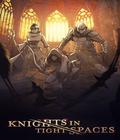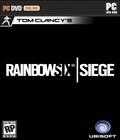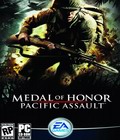Genre: First-person Shooter
Publisher: EA Games
Developer: EA LA
Release Date: November 3, 2004
Buy 'MEDAL OF HONOR: Pacific Assault': CD-ROM | DVD-ROM
Not many people really know about the Pacific theatre of World War II, and while very few people are totally oblivious to the battles that took place in the Pacific, not many know enough about it to explain what happened. The Pacific theatre is rarely seen in videogames, making Medal of Honor: Pacific Assault a sort of breath of fresh air in the horde of World War II games. MoH:PA is a cinematic, gripping look at some of the more harrowing battles of the Pacific theatre of war, and while it has its fair share of rough edges, there is still plenty of genuine WW2 action to be had.
In MoH:PA you play as Tom Conlin, a member of a squad of Marines sent into the jungles of pretty much every major battle that took place in the Pacific. Firstly you play through boot camp which details the gameplay features seen in MoH:PA, after which you are sent to your first assignment: Pearl Harbor. One minute, you are watching a group of bumbling young sailors foolishly try to hide a girly mag from a superior officer and the next, you are scrambling down a dock as explosions rip trucks apart and Japanese Zeros strafe the bejesus out of anyone caught standing still. It is this level of ferocity that is seen often through the game’s single player campaign; if you aren’t taking out the odd Japanese patrol, you are mounting daring attacks or pitching defenses against a significantly larger Japanese force.
MoH:PA mixes up your standard run-and-gun FPS action by introducing a few new features. First up is the ability to give rudimentary orders to your squad mates, such as to press ahead, fall back, give suppressing fire, or to form on you. Whenever the situation permits, your HUD will automatically show the possible orders you can issue in the top right corner of your screen, and all you do is quickly tap the corresponding arrow key, and Tom Conlin will shout the command for the rest of the squad to follow. While this is rather limited in scope, it does bring a little extra to the table, and correct usage of tactics will often make completing objectives easier in the long run. There often isn’t much of a dire need to use the commands, as your squad mates tend to be fairly on the ball as to stick by you and press when they have the advantage, but it’s nice to be able to tell your buddies to move up when you don’t want to spearhead a charge with 8 hp and half a clip of ammo.
Another feature that MoH:PA mixes up a bit is the method used to recover health. Rather than shoving your feet into health kits or the like, MoH:PA makes you call upon your squad’s corpsman, a.k.a. medic. By calling over your corpsman, he brings your health back up to full and uses part of his limited medical supplies. However, there are times where the corpsman simply can’t get to your position, and you must get to him before you can get healed. If you lose all of your health, you fall to the ground, and the screen takes a blurred black and white look, giving you a limited time to call out for your corpsman. One of three things can happen here; you can either simply die because your corpsman can't reach you in time, the corpsman actually gets to you and brings you back to your feet with full health (and less medical supplies as stated earlier), or the alternative to both of those, in which a Japanese soldier gets there first and slams his boot into your face.
MoH:PA, much like MoH: Allied Assault, is fairly historically accurate. Uniforms and languages on both sides of the battle are represented well, as are the guns and islands themselves. For players really interested in their battle facts, the Director’s Edition enables pop-up facts which appear at the top of the screen, about everything from gun specifications to short blurbs about the battles on the islands. Actual footage shot in the Pacific during WW2 is frequently used in game, such as the sobering view of ships burning in Pearl Harbor. Additional footage can be viewed from the main menu if the player so desires, such as that of the silent Marine drill team.
Now, ragdoll effects by themselves in a videogame are nothing to write home about. However MoH:PA uses its physics engine to a rather extensive effect. Sure, enemies who take that final bullet will drape themselves onto whatever rock, tree, or object they fall onto, will tumble down slopes, and fall off of towers and over bamboo railings. However, where the physics engine really shines in how it is implemented in the more unexpected ways. Blasting a barrel of explosives next to a guard tower will cause it to crumble down in physics-fueled glory, and explosions will cause the walls of a shaky metal shanty to break apart. Indeed, the player can find himself nearly pinned to the ground after a tank shell literally blows a metal shed apart, causing an entire wall to land on top of him.
There are a few aspects of MoH:PA that, while patchable, will still aggravate the heck out of the player. The biggest one is that of the rampant clipping errors that affects pretty much every object in the game. You can take your time and carefully line up a headshot on an enemy soldier who is standing in a window of a hut and fire, only to have the bullet explode in bits of wood and bamboo in front of his face as if there weren’t a window there to begin with. Thusly, most of the time when shooting at enemies who are taking cover, you are trying to find the magic spot that actually hits them rather than aiming for spots that will do more damage that will usually be obstructed by clipping errors. Additionally, it can be quite irksome to have a Japanese soldier suddenly come out from cover and bayonet you as you reload, in that the player’s soldier is hell-bent on finishing the reload before anything else. I don’t know about you, but I’d guess your standard infantryman would rather drop those five rounds for his Springfield and club the advancing enemy rather than to die due to multiple stab wounds from a six-inch blade. Another problem that will bug MoH:PA players is that the game’s engine feels a bit unoptimized and almost a bit sluggish at times, even on systems that vastly outpace the recommended specs. The keyboard controls and mouse aim are responsive as one would expect, but there is a noticeable delay between the click of the mouse and the actual firing of the player’s weapon. Load times are a bit on the longish side, with about a 30-second load time per instance, regardless of the fact that you died not 15 seconds past a recent game save.
MoH:PA’s graphics are borderline incredible, all things equally considered. The character models are intricately detailed and show believable facial expressions in both gameplay and cinematic sequences. Animations are equally realistic, whether it be the way a hunched-over soldier makes his way through the jungle or the way a Japanese soldier holds his rifle up in a bonsai charge. Effects such as smoke and fire look a lot like their real life counterparts, soldiers firing their weapons get gently lit by their own muzzle flashes, and even the subtle effect of the way a grenade explosion affects the nearby undergrowth is startlingly represented. Trees overhead cast shadows down onto the soldiers themselves as well as your weapon, which is a subtle and yet powerful effect.
However, on the sound end of the spectrum, MoH:PA falls a bit short of greatness. Authentic sounds or not, the weapon effects just don’t sound very powerful at all. Though I loathe making direct comparisons, in Call of Duty, weapons and ambient sound effects did everything short of grip you by the throat and slam your face into your subwoofer. Meanwhile, the weapon sounds in MoH:PA actually lessen the immersion somewhat, even in normally glorious 5.1 surround sound. The musical score is of consistently high quality, with everything from tense music for those night excursions into hostile territory, fast-paced music that plays when you are hauling down a dock in Pearl Harbor with a Zero strafing everything nearby, and even actual radio broadcasts and commercials that play during the main menu which shows your squad sitting in their current barracks.
Overall, Medal of Honor: Pacific Assault is sort of a mixed blessing. On the plus side, the Pacific theatre of WW2 is a fresh view of that same old war, everything is about as authentic as it can get without sacrificing playability, and the new features do well to break up what easily could have been yet another WW2-themed FPS. However, the clipping errors, other aggravating issues, and rather weak-sounding weaponry do detract from the overall experience. Still, MoH:PA is a fun title and you can’t really go wrong with it, given that said issues can foreseeably be fixed in a future patch, and there is plenty of content to experience. It can be a tense moment indeed when your squad is pinned down by a charging enemy squad backed by a machine gun nest, and the battle of Pearl Harbor is presented with a gripping suspense unrivaled by anything short of witnessing it firsthand. All in all, MoH:PA has its flaws, sure, but there are also quite a few things that offset those flaws and make the title at least worthy of a serious glance.
Score: 8.7/10
More articles about Medal Of Honor: Pacific Assault












 Step into the boots of a U.S. Marine and drive the Imperial Japanese Army from the Pacific in Medal of Honor Pacific Assault.
Step into the boots of a U.S. Marine and drive the Imperial Japanese Army from the Pacific in Medal of Honor Pacific Assault.











































